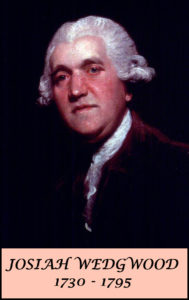Josiah Wedgwood
 Josiah Wedgwood (12 July 1730 – 3 January 1795), is at first blush an unlikely personage to be included in a collection of information about intaglios — he was a potter, right? We’ve all seen those white porcelain designs on blue background medallions, plates, fancy boxes, vases, and the like — that’s Wedgwood; at least that’s what I thought.
Josiah Wedgwood (12 July 1730 – 3 January 1795), is at first blush an unlikely personage to be included in a collection of information about intaglios — he was a potter, right? We’ve all seen those white porcelain designs on blue background medallions, plates, fancy boxes, vases, and the like — that’s Wedgwood; at least that’s what I thought.
Then one day I bought several small intaglio carved black stones with profile busts engraved on their surface. A couple of them were stamped “Wedgwood & Bentley” on the back. After a little research, I discovered that they were produced by, of course, Wedgwood during the second half of the 18th Century.
These intaglios are referred to as “black basalts”. They are covered in more depth with a number of example images on the sub-menu page entitled, “Basalt Intaglios“.
My investigation into the background of the Wedgwood intaglios led me to find out a whole lot about the man and his work. He was not only a potter, but so much more; a chemist, an artist, an astute businessman, a master marketer, an innovator, and, in fact, a very important figure in the birth of the industrial revolution. A concise biography of Wedgwood as a business man accompanied by multiple sources and references can be found at SPARTACUS-EDUCATIONAL. An excellent, more in depth biography is “Wedgwood: The First Tycoon” by Brian Dolan (take a quick look inside the book at Amazon).
WARNING!!! A casual interest in Josiah Wedgwood, the man, can soon lead to a more time consuming study of him, and ultimately, of the times in which he lived. I speak from experience — that’s why I have strayed so far from my stated topic of intaglios.
While there is not much in the way of specific literature about the intaglios produced by Wedgwood, a search of his name returns numerous books and articles many of which include short sections on the intaglios. There are several catalogues of Wedgwood-ware that were published in the 18th century which include a listing of the intaglios. One dated 1787 can be found at https://archive.org/details/catalogueofcameo00wedg .